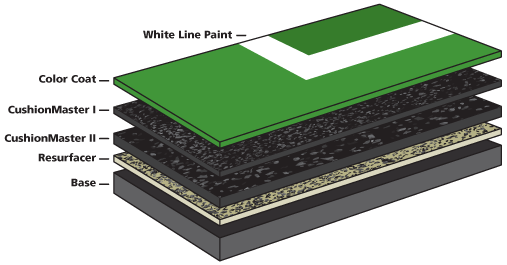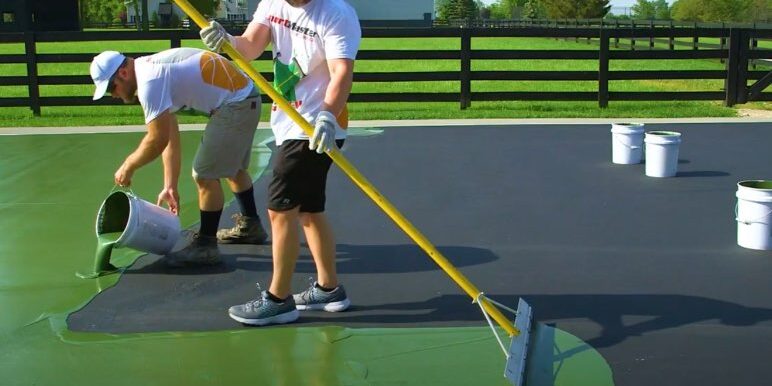Custom Pickleball Court Construction for Residential and Commercial Spaces
Wiki Article
Sustainable Practices in Pickleball Court Building You Must Know
As the popularity of pickleball continues to increase, so also does the demand for lasting practices in court building. The influence of these practices prolongs far beyond the court itself.Selecting Eco-Friendly Products
Picking environmentally friendly products is an essential action in the building and construction of sustainable pickleball courts. The selection of sustainable materials not just lessens ecological influence but likewise enhances the long life and efficiency of the court. Trick materials consist of reused rubber for the surface, which supplies superb durability and shock absorption while diverting waste from garbage dumps.Additionally, utilizing locally sourced products minimizes transport exhausts and sustains local economic situations. Pickleball court construction. Utilizing native hardwoods for fence and seating can supply a sustainable visual while making sure strength versus the aspects.
Integrating permeable materials for court structures can even more add to sustainability by enabling all-natural water drain and decreasing drainage. These options not only safeguard neighborhood ecological communities but likewise advertise healthier play settings.
Effective Drainage Solutions
While the choice of environmentally friendly materials is crucial, implementing reliable drain remedies is just as essential for keeping lasting pickleball courts. Correct water drainage not just protects the court surface area from water damage but also reduces erosion and overflow, promoting ecological stability.Efficient drain systems can include permeable paving, which allows water to penetrate the ground instead than merging on the surface. This minimizes the possibility of standing water, which can bring about mold and mildew and various other maintenance issues. Additionally, incorporating tactically positioned drainage channels and swales can guide excess water far from the court location, making certain a dry playing surface area and avoiding soil erosion.
Making use of native plants in the landscaping around the courts can better enhance drainage by taking in excess water and reducing overflow. These plants need less watering and advertise biodiversity, aligning with sustainable techniques.
Moreover, it is important to on a regular basis maintain the drain system to ensure its lasting performance. This consists of clearing debris and surveillance for blockages. By focusing on efficient drain options, pickleball court builders can considerably add to the sustainability and durability of the center, eventually profiting both gamers and the environment.
Energy-Efficient Lighting Options
As the need for pickleball continues to expand, incorporating energy-efficient lights alternatives right into court layout has actually ended up being progressively crucial for sustainability. Typical lights systems usually take in excessive power, adding to greater functional expenses and environmental impact. Embracing contemporary, energy-efficient technologies is essential for both brand-new buildings and renovations.LED (Light Emitting Diode) illumination stands apart as a top option as a result of its long life and energy savings (Pickleball court construction). Compared to standard lights, LEDs utilize approximately 75% less power and can last approximately 25 times longer, significantly minimizing maintenance expenses. The directional nature of LED illumination decreases light contamination, making certain that illumination is focused on the court instead than surrounding locations.

Sustainable Surface Area Alternatives
Exploring lasting surface alternatives for pickleball courts has gotten traction among builders and gamers alike. The emphasis on green materials not just lines up with the growing ecological recognition but likewise enhances the performance and sturdiness of the courts.One popular option is using recycled rubber, which can be sourced from utilized tires. This material provides superb shock absorption, reducing the danger of injuries for players while promoting sustainability. In addition, modular tiles made from recycled plastics provide one more feasible alternative. These floor tiles are easy to set up and change, and their convenience enables numerous court arrangements.
Natural lawn courts are additionally arising as a lasting option, advertising biodiversity and reducing the heat island result. They call for regular maintenance and water, which may not line up with all sustainability goals.

Water Preservation Techniques

One more effective method entails the installation of rain harvesting systems. These systems save and accumulate rain for usage in maintaining court surface areas and landscaping. This technique not just saves potable water but likewise reduces reliance on metropolitan sources.
Moreover, utilizing drought-resistant landscaping around the courts is important. Indigenous plants need less water and are better adapted to neighborhood climate conditions, therefore reducing overall water intake. Additionally, utilizing reliable watering systems, such as drip irrigation, guarantees that water is delivered straight to plant origins, minimizing dissipation and waste.
Conclusion
Integrating lasting practices in pickleball court construction dramatically adds to ecological conservation and source effectiveness. Making use of green products, applying effective drain options, and find more information embracing energy-efficient lights choices can greatly minimize environmental effect. Checking out lasting surface area alternatives and employing water preservation methods boost the overall sustainability of these recreational facilities. By focusing on these techniques, the building of pickleball courts can align with broader environmental objectives while promoting longevity and functionality within neighborhoods.As the appeal click to find out more of pickleball continues to climb, so too does the need for sustainable practices in court construction.Selecting environment-friendly products is an important step in the construction of lasting pickleball courts. By prioritizing energy-efficient lights alternatives, pickleball court manufacturers can add to an extra lasting future while satisfying the demands of players and stakeholders alike.Including sustainable surface area choices not only improves the efficiency of pickleball courts however also paves the means for carrying out effective water preservation methods.Including lasting practices in pickleball court construction significantly contributes to ecological preservation and source effectiveness.
Report this wiki page